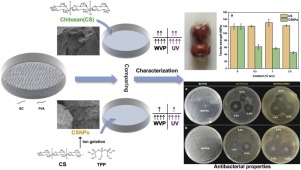Carbohydrate Polymers ( IF 11.2 ) Pub Date : 2020-03-12 , DOI: 10.1016/j.carbpol.2020.116167 Siyi Ju , Fenglun Zhang , Jiufang Duan , Jianxin Jiang

|
Ternary composite films containing bulk chitosan (CS) and chitosan nanoparticles (CSNPs) with different concentrations were prepared using bacterial cellulose/poly(vinyl alcohol) as the base film and the composites films were compared. The micromorphology and mechanical, physical, chemical, antibacterial, and optical barrier properties of the composite films were compared. CS incorporation improved the mechanical properties, as the maximum tensile strength was increased to 130.55 ± 9.42 MPa. The dense structure of CSNPs prevented water diffusion and lessened the water content of the composite membranes. The inclusion of CS and CSNPs both reduced the water solubility and water vapor permeability. CS-doped films possessed good transparency, while CSNPs had better ultraviolet-barrier properties (3.84% of transmittance at 200 − 280 nm). In addition, CSNPs-embedded membranes exhibited prominent antibacterial properties against Escherichia coli and Staphylococcus aureus, which were much greater than those of CS composite membranes with a maximum bacteriostatic diameter of 10.33 ± 1.55 mm.
中文翻译:

掺入大量壳聚糖和壳聚糖纳米颗粒的细菌纤维素复合膜的表征:对比研究
以细菌纤维素/聚乙烯醇为基膜,制备了含有不同浓度的壳聚糖(CS)和壳聚糖纳米粒子(CSNPs)的三元复合膜,并对复合膜进行了比较。比较了复合薄膜的微观形貌和机械,物理,化学,抗菌和光学阻挡性能。随着最大抗拉强度增加到130.55±9.42 MPa,CS的掺入改善了机械性能。CSNPs的致密结构阻止了水的扩散并降低了复合膜的水分含量。包含CS和CSNP均降低了水溶性和水蒸气渗透性。掺杂CS的薄膜具有良好的透明度,而CSNP具有更好的紫外线阻隔性能(在200-280 nm处的透射率为3.84%)。此外,大肠杆菌和金黄色葡萄球菌,比CS复合膜大得多,最大抑菌直径为10.33±1.55 mm。



























 京公网安备 11010802027423号
京公网安备 11010802027423号